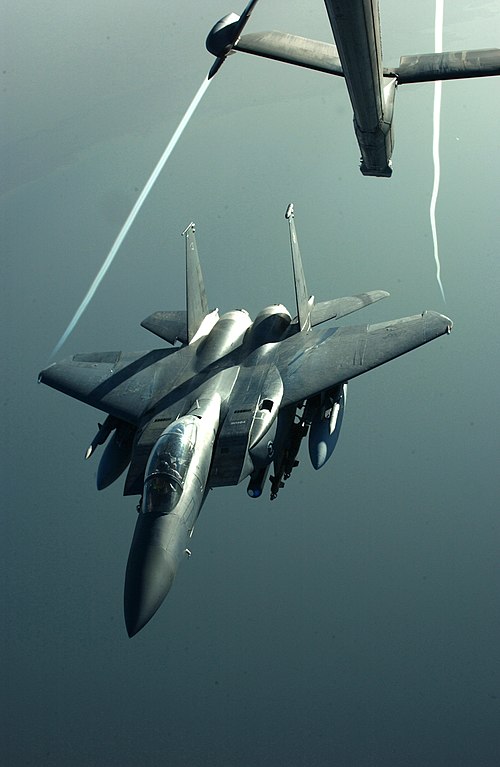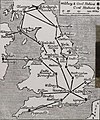| Main page | Categories & Main topics |
|
Tasks and Projects |
The Aviation Portal

Aviation includes the activities surrounding mechanical flight and the aircraft industry. Aircraft includes fixed-wing and rotary-wing types, morphable wings, wing-less lifting bodies, as well as lighter-than-air aircraft such as hot air balloons and airships.
Aviation began in the 18th century with the development of the hot air balloon, an apparatus capable of atmospheric displacement through buoyancy. Some of the most significant advancements in aviation technology came with the controlled gliding flying of Otto Lilienthal in 1896; then a large step in significance came with the construction of the first powered airplane by the Wright brothers in the early 1900s. Since that time, aviation has been technologically revolutionized by the introduction of the jet which permitted a major form of transport throughout the world. (Full article...)
Selected article
A hot air balloon consists of a bag called the envelope that is capable of containing heated air. Suspended beneath is the gondola or wicker basket (in some long-distance or high-altitude balloons, a capsule) which carries the passengers and a source of heat. The heated air inside the envelope makes it buoyant since it has a lower density than the relatively cold air outside the envelope. Unlike gas balloons, the envelope does not have to be sealed at the bottom since the air near the bottom of the envelope is at the same pressure as the surrounding air. In today's sport balloons the envelope is generally made from nylon fabric and the mouth of the balloon (closest to the burner flame) is made from fire resistant material such as Nomex.
Recently, balloon envelopes have been made in all kinds of shapes, such as hot dogs, rocket ships, and the shapes of commercial products. Hot air balloons that can be propelled through the air rather than just being pushed along by the wind are known as airships or, more specifically, thermal airships. (Full article...)
Selected image
Did you know
...that Chris Phatswe committed suicide by crashing his Air Botswana plane into two other planes belonging to the airline, effectively crippling operations? ...that Frenchman Jean-Marie Le Bris accomplished the world's first powered flight in 1856, with a glider that was pulled behind a running horse? ... that Jimmy Doolittle commanded a 22 plane demonstration celebrating the opening of Henderson, Kentucky's Audubon Memorial Bridge in 1932?
General images -
In the news
- May 29: Austrian Airlines cancels Moscow-bound flight after Russia refuses a reroute outside Belarusian airspace
- August 8: Passenger flight crashes upon landing at Calicut airport in India
- June 4: Power firm helicopter strikes cables, crashes near Fairfield, California
- January 29: Former basketball player Kobe Bryant dies in helicopter crash, aged 41
- January 13: Iran admits downing Ukrainian jet, cites 'human error'
- January 10: Fire erupts in parking structure at Sola Airport, Norway
- October 27: US announces restrictions on flying to Cuba
- October 3: World War II era plane crashes in Connecticut, US, killing at least seven
- September 10: Nevada prop plane crash near Las Vegas leaves two dead, three injured
- August 6: French inventor Franky Zapata successfully crosses English Channel on jet-powered hoverboard
Related portals
Associated Wikimedia
The following Wikimedia Foundation sister projects provide more on this subject:
-
Commons
Free media repository -
Wikibooks
Free textbooks and manuals -
Wikidata
Free knowledge base -
Wikinews
Free-content news -
Wikiquote
Collection of quotations -
Wikisource
Free-content library -
Wikiversity
Free learning tools -
Wikivoyage
Free travel guide -
Wiktionary
Dictionary and thesaurus
Selected biography
Elbert Leander "Burt" Rutan (born June 17, 1943 in Estacada, Oregon) is an American aerospace engineer noted for his originality in designing light, strong, unusual-looking, energy-efficient aircraft. He is most famous for his design of the record-breaking Voyager, which was the first plane to fly around the world without stopping or refueling, and the suborbital rocket plane SpaceShipOne, which won the Ansari X-Prize in 2004.
Selected Aircraft

NASA's Space Shuttle, officially called the Space Transportation System (STS), was the spacecraft which was used by the United States government for its human spaceflight missions. At launch, it consisted of a rust-colored external tank (ET), two white, slender Solid Rocket Boosters (SRBs), and the orbiter, a winged spaceplane which was the space shuttle in the narrow sense.
The orbiter carried astronauts and payload such as satellites or space station parts into low Earth orbit, into the Earth's upper atmosphere or thermosphere. Usually, five to seven crew members rode in the orbiter. The payload capacity was 22,700 kg (50,000 lb). When the orbiter's mission was complete, it fired its Orbital Maneuvering System (OMS) thrusters to drop out of orbit and re-enter the lower atmosphere. During the descent and landing, the shuttle orbiter acted as a glider, and made a completely unpowered ("dead stick") landing.
- Span: 78.06 ft (23.79 m)
- Length: 122.17 ft (37.24 m)
- Height: 58.58 ft (17.25 m)
- Engines: 3 Rocketdyne Block 2 A SSMEs
- Cruising Speed: 25,404 ft/s (7,743 m/s, 27,875 km/h, 17,321 mi/h)
- First Flight: August 12, 1977 (glider), April 12, 1981 (powered).
- Operational Altitude: 100 to 520 nmi (185 to 1,000 km)
- Number built: 6 (+2 mockups)
Today in Aviation
- 2012 – The People's Republic of China conducts its first carrier flight operations with fixed-wing aircraft, when the People's Liberation Army Navy aircraft carrier Liaoning launches and recovers the Shenyang J-15 fighter for the first time.[1]
- 2012 – Two military OV-10 Broncos collide in the air during a demonstration flight near military El Libertador Air Base in the state of Aragua, Venezuela. One of the pilots is killed, guiding the aircraft away from a populated area. Three soldiers are also injured in the crash.
- 2009 – An Aeronautica Militare Italiana Lockheed Martin C-130J Hercules, MM62176, c/n 5497, '46-41', engaged in a training mission crashes on nearby train tracks bordering the Pisa airport, while climbing and performing a left turn immediately after take-off from Galileo Galilei Airport. The aircraft immediately burst into flames, killing its five-member crew.
- 2002 – Launch: Space Shuttle Endeavour STS-113 at 19:38:25 UTC. Mission highlights: ISS assembly flight 11A: P1 truss, crew rotation, last successful mission before STS-107 (the Columbia Disaster).
- 1978 – Royal Navy McDonnell-Douglas Phantom FG.1 XT598, used for trials installations at HSA Holme and A&AEE, Boscombe Down, then passed to 111 Squadron, was written off on approach to RAF Leuchars.
- 1996 – Ethiopian Airlines Flight 961, a Boeing 767, is hijacked over Kenya. The aircraft runs out of fuel, and the pilot attempts to ditch the aircraft in the ocean off Moroni, Comoros. Of the 175 people on board, 125 were killed (including the 3 hijackers).
- 1989 – An Airbus A310-300 opens Air France’s new direct Lyon/New York service.
- 1985 – EgyptAir Flight 648, a Boeing 737, is hijacked by Palestinian militants. Egyptian special forces storm the plane on the island of Malta. The incident kills 58 out of 90 passengers and all but one of the hijackers.
- 1973 – First flight of the AIDC T-CH-1
- 1973 – Argo 16, an Italian Air Force C-47 used by the Italian Secret Service and the Central Intelligence Agency in covert operations, crashed in Marghera, Italy after an improvised explosive device detonated. The explosion and the subsequent crash killed the four operatives on board.
- 1964 – TWA Flight 800, a Boeing 707, suffers engine failure and crashes at Leonardo da Vinci-Fiumicino Airport, killing 50 of 73 on board; the cause is an inoperative thrust reverser.
- 1962 – United Airlines Flight 297, a Vickers Viscount 745D, crashes near Ellicott City, Maryland, following a bird strike; all 17 people on board died.
- 1961 – Aerolíneas Argentinas Flight 322, a de Havilland Comet 4, crashes in Campinas, Brazil shortly after takeoff, killing all 12 crew and 40 passengers on board.
- 1959 – First flight of the Boeing 720
- 1953 – USAF pilot 1st Lt. Felix Moncla and radar operator 2nd Lt. Robert L. Wilson take of in a F-89C Scorpion from Kinross Air Force Base, Kincheloe, Michigan investigating an unusual target on radar operators. Wilson had problems tracking the object on the Scorpion's radar, so ground radar operators gave Moncla directions towards the object as he flew. Flying at some 500 miles per hour, Moncla eventually closed in on the object at about 8000 feet in altitude. Ground radar showed both the unidentified craft and the Scorpion suddenly disappearing from screen after intersecting. It is presumed the Scorpion crashed into Lake Superior, though no confirmed traces of the craft or Moncla and Wilson have been found.
- 1949 – Introduction: Convair XC-99
- 1947 – First flight of the Convair XC-99
- 1946 – An Avro Lancastrian powered by two Rolls-Royce Merlin piston engines and two Rolls-Royce Nene turbojets returns from Paris to London in just 41 minutes. The flight from London to Paris was made on November 17. The "Nene Lancastrian" only uses its Merlins for takeoff and landing, becoming the first transport aircraft to fly solely on jet power.
- 1943 – The Deutsche Luftfahrt Sammlung (Berlin Air Museum), at Lehrter Bahnhof, is destroyed in an RAF bombing raid by 383 aircraft: 365 Avro Lancasters, 10 Handley Page Halifaxes, and 8 de Havilland Mosquito bombers. Many exhibited aircraft are destroyed, including the Dornier Do-X, and the Focke-Wulf Cierva C.19a demonstrator, Wrke Nr. 35, D-1960 / D-OBIR. Surviving types are moved E from Berlin where they are discovered post-war. Most of these survivors are now in the Muzeum Lotnictwa Polskiego w Krakowie, the Polish Aviation Museum, at Kraków, Poland.
- 1942 – First flight of the Vought XF5U
- 1942 – First flight of the Vought V-173
- 1937 – During the Great Purge, Soviet Air Force commander-in-chief Comandarm Yakov Alksnis is arrested.
- 1934 – First flight of the Bloch MB.210
- 1923 – First of only three Bristol Jupiter Fighters, essentially adaptations of the Bristol F.2B airframe converted with 425 hp (317 kW) Bristol Jupiter IV engines and oleo-type undercarriage, crashes due to an engine seizure at high altitude. Second conversion was sold to Sweden in May 1924, and third was converted to a dual-control trainer.
- 1916 – British ace Lanoe Hawker VC is shot down by Manfred von Richthofen.
References
- ^ Axe, David (November 26, 2012). "China's Aircraft Carrier Successfully Launches Its First Jet Fighters". Wired.co.uk. Retrieved December 2, 2012.
- Shortcuts to this page: Portal:Airplanes • P:AVIA




















































